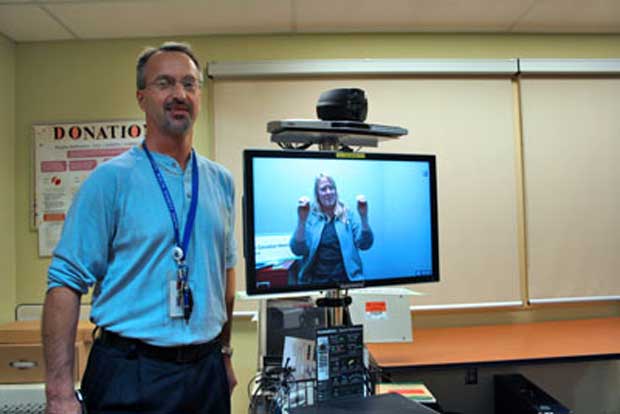

THUNDER BAY – Health News – ASL Interpretive Service via Telemedicine is a sign of things to come. A new American Sign Language (ASL) interpretive service is now available to patients in the Emergency Department and the ICU at the Thunder Bay Regional Health Sciences Centre for emergency situations using Telemedicine.
ASL interpreters are available at the Health Sciences Centre to help culturally deaf patients communicate with their care team as needed. However, finding an interpreter after hours in emergency situations can be a challenge. Ontario Interpreting Services (OIS) in Oshawa, operated by the Canadian Hearing Society, allows an interpreter in Oshawa to be “present” via videoconference within minutes through the Ontario Telemedicine Network (OTN).
Glenda Messier, an interpreter with OIS, said that in most cases an interpreter can be available within 15-30 minutes in emergency situations. The quality of the video-conferencing equipment allows the patient and the interpreter to sign naturally.
“The camera has to be on the deaf patient, but it doesn’t matter if they are standing up, sitting up, or lying down,” Messier said, adding that the only real restriction is how close the camera is on the patient’s hands and face. That’s not a problem though since the high-definition camera can zoom in as closely as needed.
ASL Interpretive Services via Telemedicine:
The technology behind the new service could prove useful in many situations. Trina Diner, Manager of Palliative Care and Telemedicine Services at the Thunder Bay Regional Health Sciences Centre, said that several technical challenges had to be overcome. To hook up directly to the network, the system would need network jacks in each of the 22 ICU rooms and throughout patient areas in the Emergency Department. However, that was not a practical option.
“To add a network line into every single room and then to have enough routers to connect to those lines is cost and space prohibitive,” Diner said.
Wireless would be the next obvious solution, but the Health Sciences Centre has avoided wireless Telemedicine connections in the past, simply because they are typically harder to secure – until now. This past October, the Telemedicine Service launched a wireless and fully secure portable unit that can go to any room within the ICU or the Emergency Department and video-conference with any of the 2,000 OTN sites across the province.
JJ Hupka, OTN Regional Manager, said that this new wireless system not only increases accessibility to care for culturally deaf patients, but also increases access to Telemedicine in general.
“The use [for ASL interpretive services] may be sporadic, but OTN can support the service for emergency use as well as other services that Health Sciences Centre staff identify,” Hupka said.
One of those uses is Tele-Visitation. For example, a patient in ICU could talk to family in the region or across Ontario via videoconferencing. That was more difficult before.
“The wireless part makes a big difference for our patients, because we can’t always wheel them to a [hardwired] network connection,” said Wendy Winslow, Manager of Critical Care Services. “We were limited to just families who could come into the room, or physicians speaking with families in the region. It is great that all of our patients can participate now.”
Flexibility was key to this project, Diner said.
“When we push the technology for one reason, we can layer on top of that for all of these other uses,” Diner said. “What I’m hoping is that if we can expose the nursing staff and physicians to this type of technology and show them how useful it can be, they’ll get comfortable with it and use it more and more.”






